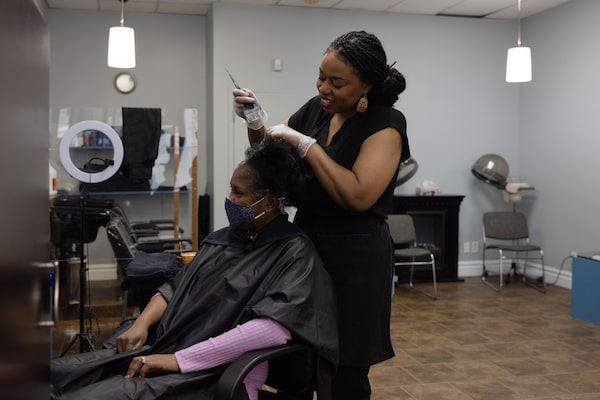
Tracey Crawley, Owner of Crowning Glory Hair Studio, works on a hair relaxing treatment for a client in Dartmouth, Nova Scotia, on June 24.Carolina Andrade/The Globe and Mail
The pandemic was hard for Moluk Fard, a tailor who runs her own clothing-alterations business, Needle & Thread, in midtown Toronto. With events shuttered and so many of her customers working from home, there were stretches when she wasn’t sure if she could make rent.
But that started to change this spring, in a big way. Businessmen began to bring in suits in preparation for big meetings. Bridesmaids brought in dresses for long-delayed weddings. And, starting in late May, she saw a surge in high-school students bringing in their outfits for prom.
She said that so many of her work-from-home clients had needed their clothes let out because they had put on weight that she had started a joke with them to help them feel better.
“Always, I’m saying, ‘Oh, the clothes, they shrank!’” Ms. Fard said.
Businesses like Ms. Fard’s alterations shop – such as dry cleaners, hair stylists and suit retailers – have had a rough go during the pandemic, as demand for their services dropped precipitously and many business owners decided to close or move into other fields.
Commercial rent prices are rising, and many small businesses are finding it hard to keep up
Inside the corporate dash to buy up dentists’ offices, veterinary clinics and pharmacies
But those who have continued say that, whether or not revenue is back to where it used to be, things have gotten a whole lot better in recent weeks and months.
Tracey Crawley, owner of the Crowning Glory Hair Studio in Dartmouth, N.S., said the last two years had been a boom-and-bust cycle where lockdowns would keep her closed for months at a time, and then she would be run off her feet during reopenings because of pent-up demand among her clients.
“That first lockdown was a bit challenging,” she said. “The second time, I actually just welcomed the time off because, I’m like, I’m tired.”
She said the return of weddings and school dances this summer has led to a surge in clients and the need to sometimes open early, stay late, or come in on a day off. She said the added revenue has more than made up for the losses she endured during downtimes.
Working-from-home and remote work has been devastating to downtown businesses that relied on office workers for their clientele. But, while one in five Canadians still works from home, according to Statistics Canada’s most recent labour force survey, there has been a slow return to the office – at least some of the time. For example, according to the Toronto Region Board of Trade, foot traffic from downtown Toronto workers was down about 20 per cent this spring from its pre-pandemic levels – much smaller than the 70-per-cent drop measured in 2020.
Tom Mihalik, owner of the popular men’s clothing store Tom’s Place in Toronto’s Kensington Market neighbourhood, said his revenue is “close” to what it had been pre-pandemic, as bankers and lawyers return to his suit shop for the first time in years.
“Our Bay Street clients are back in a big way,” Mr. Mihalik said.
He said one revenue stream that helped keep him afloat during the downtimes was supplying suits for film and TV productions, such as The Boys and The Handmaid’s Tale, which kept filming in and around Toronto with tight COVID-19 protocols.
For some industries, though, there is a dawning realization that things will never be the same again.
Those in the dry-cleaning industry say customers have been drifting back, but revenue is still down some 30 per cent of pre-pandemic levels. And the last two years only accelerated trends that had already been going on for years, such as a rise in working from home, relaxed clothing standards in the office, and attire that doesn’t need special treatment by a professional. According to Statistics Canada, about 500 dry-cleaning and laundry businesses closed in the first year of the pandemic, with 4,001 remaining in 2021.
Dino Kantzavelos, owner of TSC Wetclean in Mississauga and president of the Canadian Fabricare Association industry group, said dry cleaners are trying to adapt their services to changing customer needs.
Number one on that list has been pickup and delivery. Mr. Kantzavelos said that for his own business – which specializes in cleaning without solvents – pickup and delivery has grown to 40 per cent of his revenue, up from 15 per cent three years ago. He said it’s grown especially fast in the last few months as customers go back to the office and don’t have the time to visit a dry cleaning location, and he is getting to the point where his shop will need to hire a second vehicle to keep up with demand.
Like the dry cleaners, Ms. Fard said her revenue still hasn’t fully recovered, and she is still only making about two-thirds of what she made before everything changed.
Still, she said, many of her clients have started to return and for the first time in two years, she is starting to feel like things are getting back to normal.
“I am happy with that,” she said. “At least I don’t have to touch my line of credit.”
Get the Report on Small Business newsletter, essential reading for hard-working entrepreneurs pursuing growth and expansion. Sign up today.